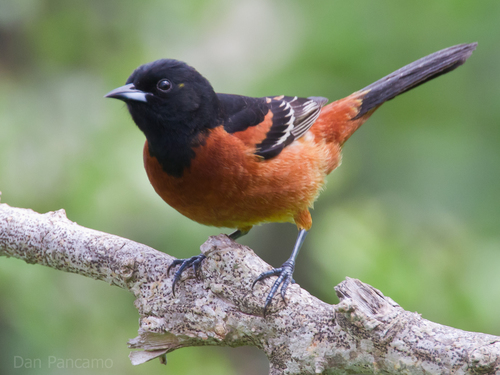
Orchard Oriole
The Orchard Oriole (Icterus spurius) is the smallest oriole in North America, known for its distinct sexual dimorphism and melodious song. Unlike many other orioles, the male Orchard Oriole sports a rich chestnut and black plumage, rather than the typical bright orange. These birds play a vital role in their ecosystems, primarily as insectivores, helping to control insect populations. They also contribute to pollination as they feed on nectar. Culturally, the Orchard Oriole is less prominent than some other oriole species, but its arrival is often seen as a harbinger of spring in its breeding range.
15-18 cm
Length
23-28 cm
Wingspan
Least Concern
Conservation Status
Distribution
The Orchard Oriole breeds across eastern and central North America, from southern Canada to northern Mexico. During the winter, it migrates to Central America and northern South America, as far south as Colombia and Venezuela. Its altitudinal range varies from sea level to moderate elevations in mountainous regions.
Lifespan
Up to 11 years in the wild, though average lifespan is likely shorter.
Orchard Oriole's Habitat
Habitat Types
Open Woodlands, Orchards, Riparian Thickets, Parks, Suburban Gardens
Climate Zones
Temperate, Subtropical
Adaptations
Orchard Orioles prefer semi-open habitats with scattered trees and shrubs, which provide both foraging opportunities and nesting sites. Their preference for edge habitats allows them to exploit diverse food sources.
Variations
While no officially recognized subspecies, there can be slight variations in plumage brightness and size across their range, though these differences are generally minor.
Appearance
Breeding Plumage
Adult males in breeding plumage are chestnut below and black above, with black wings featuring a chestnut shoulder patch and white wing bars. Females and immature males are yellowish-olive above and yellow below. Non-breeding males may retain some chestnut coloration.
Seasonal Feather Changes
After breeding, males molt into a more subdued plumage, resembling females, though they typically retain some black on the throat.
Sex Based Plumage Differences
Significant sexual dimorphism. Adult males are chestnut and black, while females and immatures are yellowish-olive and yellow.
Notable Features
Smallest North American oriole., Male's distinctive chestnut and black plumage., Slender, pointed bill.
Diet and Feeding
Primary Foods
Insects, Spiders, Nectar, Fruits, Berries
Foraging Behavior
Orchard Orioles glean insects and spiders from foliage, often hanging upside down to reach prey. They also visit flowers for nectar and consume small fruits and berries, particularly during migration and in winter.
Specializations
Their slender, pointed bill is well-suited for probing into flowers and extracting insects from crevices.
Seasonal Diet Variations
Diet shifts with availability. Primarily insectivorous during the breeding season, they consume more fruits and nectar during migration and on their wintering grounds.
Behavior
Social Structure
Generally solitary or in pairs during the breeding season. May form small flocks during migration and on wintering grounds.
Communication
Rich, whistled song, often described as a chatty warble., Chattering and scolding calls., Visual displays during courtship and territorial defense.
Migration
Orchard Orioles are complete migrants, traveling between North America and Central/South America. They migrate at night, often in mixed-species flocks.
Territorial or Group Behaviors
Males defend breeding territories through song and aggressive displays. Outside of the breeding season, they are less territorial and may forage in small groups.
Conservation
Threats
Habitat loss and fragmentation, Pesticide use, Collisions with buildings and vehicles, Climate change (potential impact on breeding and wintering habitats)
Protection Programs
Conservation of riparian habitats and open woodlands., Efforts to reduce pesticide use in agricultural areas.
Local National Laws
Protected under the Migratory Bird Treaty Act in the United States.
Population Trend
Stable
Population Estimates
Global population estimated at around 14 million.
Interesting Facts
The Orchard Oriole is the smallest species of Oriole in North America.
This makes them agile and able to utilize a wider range of foraging opportunities.
Males do not attain their full adult plumage until their second year.
First-year males resemble females, which may help them avoid aggression from older males.
They are known to hybridize with other oriole species, particularly Bullock's Oriole.
This hybridization can occur where their ranges overlap.
Faqs about Orchard Oriole
What is the best way to attract Orchard Orioles to my yard?
Plant native fruit-bearing trees and shrubs, provide a source of fresh water, and offer nectar feeders. Avoid using pesticides.
How can I tell the difference between a male and female Orchard Oriole?
Adult males are chestnut and black, while females are yellowish-olive and yellow. First-year males resemble females.
Where do Orchard Orioles build their nests?
They typically build their nests in trees or tall shrubs, often near the end of a branch. The nest is a hanging pouch woven from plant fibers.
Are Orchard Orioles aggressive?
Males can be territorial during the breeding season, defending their nesting area from other males. However, they are not generally aggressive towards humans.
Copyright @ Nature Style Limited. All Rights Reserved.
 English
English